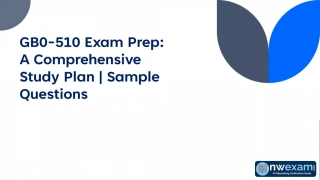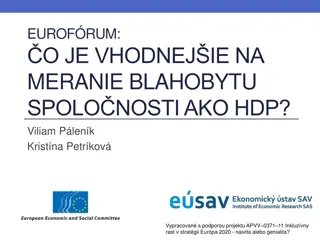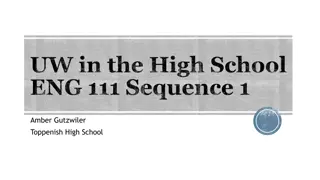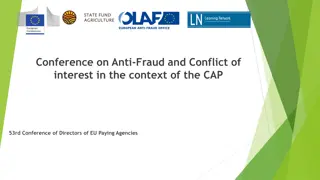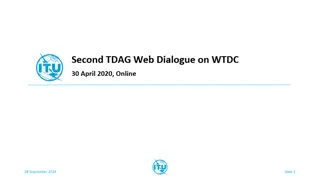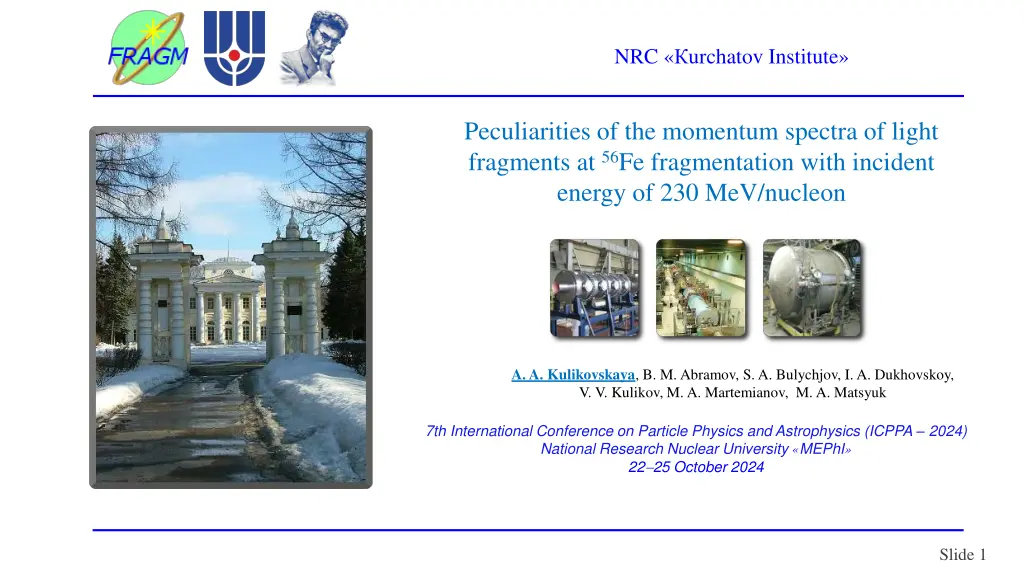
Momentum Spectra of Light Fragments in 56Fe Fragmentation at 230 MeV/nucleon
Explore the peculiarities in the momentum spectra of light fragments generated during 56Fe fragmentation at an incident energy of 230 MeV/nucleon. The study conducted at the NRC Urchatov Institute investigates the double-humped structure observed in the momentum distributions of light fragments, providing insights into nucleus-nucleus interactions and nuclear structure manifestations.
Download Presentation

Please find below an Image/Link to download the presentation.
The content on the website is provided AS IS for your information and personal use only. It may not be sold, licensed, or shared on other websites without obtaining consent from the author. If you encounter any issues during the download, it is possible that the publisher has removed the file from their server.
You are allowed to download the files provided on this website for personal or commercial use, subject to the condition that they are used lawfully. All files are the property of their respective owners.
The content on the website is provided AS IS for your information and personal use only. It may not be sold, licensed, or shared on other websites without obtaining consent from the author.
E N D
Presentation Transcript
NRC urchatov Institute Peculiarities of the momentum spectra of light fragments at 56Fe fragmentation with incident energy of 230 MeV/nucleon A. A. Kulikovskaya, B. M. Abramov, S. A. Bulychjov, I. A. Dukhovskoy, V. V. Kulikov, M. A. Martemianov, M. A. Matsyuk 7th International Conference on Particle Physics and Astrophysics (ICPPA 2024) National Research Nuclear University MEPhI 22 25 October 2024 Slide 1
Introduction The FRAGM detector has been optimized to measure the yields of fragments produced in nucleus-nucleus collisions at the TWAC heavy ion accelerator complex Experimental data were obtained at the56Fe fragmentation at 230 MeV/nucleon on three targets:9Be,27Al and64Cu; the produced fragments were detected at an angle 3.5 The FRAGM setup allows detecting in a wide range light and heavy fragments, that as a result of the analyzing correlation distributions: amplitude - time of flight. To improve the momentum profile, a hodoscope system located in the first focus of the magneto-optical channel was used Differential cross sections for light fragment production as a function of momentum allow testing models of nucleus- nucleus interactions and investigate the different manifestation of nuclear structure The obtained data showed for the first time that for small angles and for heavy projectiles the fragmentation peaks of light fragments in their momentum distributions have double humped structure, different from the Gaussian shape observed at large angles. The dependence of this splitting effect on the fragment mass and on different targets was studied and compared with the predictions of ion-ion interaction models and to the results of the similar GSI-FRS experiment Slide 2
Experimental setup FRAGM Data were collected on the heavy ion accelerator complex TWAC with 12C Total channel length: 42 m Two bending magnets: BM1 (bending angle: = ions at different energies of 300, 600, 950, 2000, 3200 MeV/nucleon and with 0.259 rad.), BM2 ( = 0.276 rad.) Five quadrupoles: Q1, 56Fe ions at energy of 230 MeV/nucleon Measurements were performed on different targets:9Be,27Al,64Cu Q5 (vertical focusing) Q2, Q3, Q4 (horizontal focusing) Scintillation counters: CF1, CF2, C2, C3 (dE/dx, TOF) F1 C2 coincidence gives trigger signal H1 hodoscope consisting from 20 vertical elements (scintillation counters, size 20 1 1 cm) Beam monitoring system consists of three scintillation TWAC Main ring counters located at angle of 2 relative to the beam line [A. A. Kulikovskaya, et al., Phys. At. Nucl. 85, 9, 1541 (2022)] Slide 3
Fragments selection in the FRAGM experiment Channel rigidity (p / Z) : 1.3 GeV/c Channel rigidity (p / Z) : 1.8 GeV/c The magneto-optical channel is adjusted to a certain rigidity selected for current data taking run 2Dim correlation distribution: TDC (TOF function of the atomic mass number, measured between CF1 and C2) vs QDC (function of dE/dx and Z of fragment defined by counter CF1). TDC channel = 0.2 ns Different fragments can be easily separated by analyzing the correlation distribution Slide 4
Differential cross section of 56Fe fragments vs momentum Tkin = 230 MeV/nucleon 9Be - target To calculate differential cross section d2 /dpd , it s important to obtain a total cross section tot(56Fe +A) The value of total cross section is calculated using LAQGSM model of ion-ion This picture demonstrates the measured differential cross section as function of momentum for different fragments from protons to14C 9Be target model gives interactions. For tot= 1579 mb Slide 5
Splitting effect in peak momentum: data and models 9Be - target The splitting effect is observed for light fragments up to6Li It s clearly seen, that the double-humped peak structure decreases fragment mass number Two models of nucleus-nucleus collisions (binary cascade BC and quantum molecular dynamics QMD) demonstrate the same behavior These models exhibit although they show different magnitudes of this effect It is obvious that the BC model shows better agreement with our data and more accurately describes the peak splitting effect with increasing peak splitting, Slide 6
Double-humped structure on different target 3H 2H 1H The experimental invariant cross section inv. = E/p2d / (d dp) was obtained on three target as function of momentum in the rest frame of incident nucleus. In the rest frame momentum distributions should be well described by Gaussian To compare the spectra profile the normalization on total cross section was done. The experimental data obtained on and64Cu targets were measured at low statistics It s clearly seen that the magnitude and profile of the peak splitting on three different targets (9Be,27Al,64Cu) demonstrate the independence of the effect from the atomic mass of the target 27Al Slide 7
Magnitude of the splitting effect To describe contribution of splitting effect to the fragmentation peak, the sum of two functions was used : Gaussian (total fragmentation peak) and polynomial function (due to splitting effect) Momentum spectra of five light elements were analyzed Hump size is calculated as the ratio of the integrals of the residue (dashed line) and total fragmentation peak (upper blue line) This values changes from 37% (protons) to 8 % (6Li) Slide 8
Protons splitting effect in the nucleus-nucleus interaction models BC SMM Angular acceptance of the FRAGM setup SMM Coulomb effect / model Slide 9
Splitting effect in the SMM model Plots shows distribution of inv. as function of momentum in the rest frame of the projectile in comparison with theoretical predictions calculated in the Statistical Multifragmentation Model (SMM) The SMM model (thanks toA. S. Botvina for code and explanations) uses the excitation energy (Eex.) as an input parameter Model data was calculated for different excitation energies from 2 to 8 MeV/nucleon, these data are normalized on our experimental results to compare the distribution shapes The best approximation with our data is given by the energy Eex. 6 MeV/nucleon for protons For light fragments from2H to6Li, the value of excitation energy can be estimated in the range 4 5 MeV/nucleon Slide 10
Angular dependence of the splitting effect BC model The data were obtained using the binary cascade (BC) and the SMM model for protons (fragmentation of depending on the fragment angle relative to the initial beam For the SMM model, excitation energy Eex. = 5 MeV/nucleon It s clear, that the peak splitting effect is strongly correlated with the angle for both models of nucleus-nucleus collisions The effect of momentum peak splitting dominates at small angles and disappears at > 5 56Fe at 230 MeV/nucleon) Slide 11
Experimental data from GSI-FRS 12C Similar experimental data were obtained in the GSI-FRS experiment at the SIS heavy-ion synchrotron Experimental data were obtained on the fragmentation of56Fe at an energy 10B of 1 GeV/nucleon on various targets (hydrogen, titanium, etc.) The detector was constructed as a magnetic spectrometer, which made it possible to measure the velocity with high accuracy A wide range of fragments heavier than Capture angle 6Li were detected, where the 6Li distortion of the spectrum shape was most clear seen It is assumed that the peak splitting effect is due to the process of asymmetric fission of the projectile nucleus The influence of Coulomb forces in the nuclear fragmentation does not 56Fe fragmentation on hydrogen target; ( || , ) in the rest frame of incident nucleus Velocity spectra in the rest frame make a significant contribution to the process of asymmetric nuclear fission Main paper : P. Napolitani et al. Phys. Rev. C 70, 054607 (2004) Slide 12
Light fragments from Au fragmentation at NICA MPD detector neutrons Neutron detector < 0.01 . Beam-1 192Au protons 2H Beam-2 Charged fragment detector 3He p / z, GeV / One of the way to calculate the luminosityon heavy ion colliders is a fragmentation method Data generated by LAQGSM model with Au Au interactions at applicability of this method to measure the luminosity on the NICAcollider It s clear seen, that splitting effect of the charged fragments has a strong double humped structure and can play an important role under designing charged particles detectors to measure the luminosity Fragmentation method of the luminosity measurement demonstrate a high counting rate as for single detector as for coincidence between two detectors ? = 11.5 GeV/nucleon was used to check the Slide 13
Conclusion The ion yields were measured during the fragmentation56Fe nuclei with an energy 0.23 GeV/nucleon on three different targets. The data were obtained using the FRAGM setup at the heavy ion accelerator-storage complex TWAC In our case, the presented data demonstrate the double humped structure of peak momentum observed on light fragments with A< 7. The effect is maximal for protons and decreases with increasing nuclear mass Two models of nucleus-nucleus interactions (BC QMD) shows the momentum peak splitting. The effect is due to the Coulomb field of the projectile nucleus The SMM model clearly demonstrates the peak splitting effect depending on the excitation energy of the light fragments, which is the input parameter of the model. The best approximation with our data for protons gives an energy value of 6 MeV/nucleon This effect was discovered in the GSI FRS experiment only on a proton target and was not observed on heavy targets. It manifested for heavier fragments with Z = 3 5. According to the authors, the source of this phenomenon is the effect of asymmetric nuclear fission Our measurements on three targets (9Be,27Al,64Cu) for the first time showed the independence of this effect from the atomic number of the target and agreement with model calculations indicates the dominant role of Coulomb effects and does not require the introduction of a new asymmetric mechanism divisions Slide 14
Thank for your attention Slide 15




